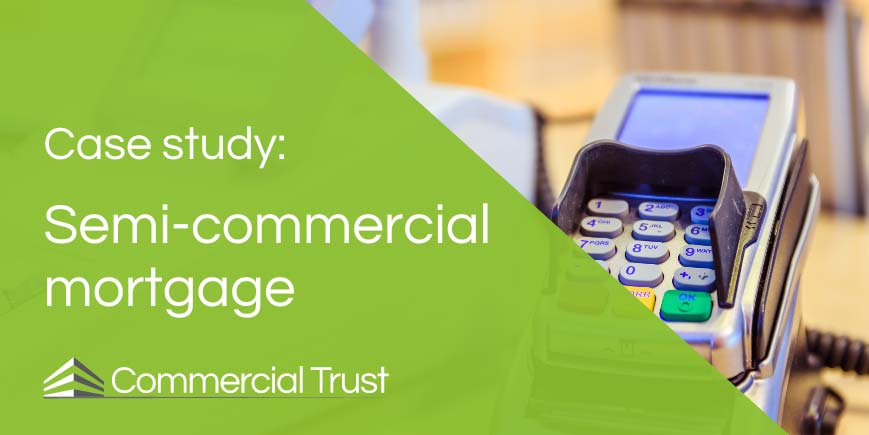This information should not be interpreted as financial, tax or legal advice. Mortgage and loan rates are subject to change.

Categories: Case study | Case study commercial mortgages
Case studySummary of the case
- Applicant was tenant looking to buy rented business premises
- Property was semi-commercial, retail space with flats above
- Client had been trading for over seven years
What did we do for the client?
- Remortgaged buy to let portfolio to raise deposit
- Obtained 70% loan to value borrowing
- Secured borrowing through trading limited company
A 5 year semi-commercial property was secured
The client in this case wanted a semi-commercial mortgage, to buy a premises they were currently renting and running their trading limited company from. The application was to be made through that business.
The deposit for the purchase was going to be raised from equity in the client’s buy to let portfolio, so we would be remortgaging those properties, to then go ahead with the semi-commercial purchase.
Fortunately, the client had many years’ experience running a successful business from the property, which strengthened the application, because under those circumstances the risk to the lender is reduced (see “How much experience do commercial lenders require?” below). The business was turning a healthy profit and had done for some years.
The client ended up putting down a 30% deposit, which we were able to raise against the buy to let property they owned.
We secured a five year fixed rate deal which was highly competitive, because semi-commercial rates are typically cheaper than pure-commercial products.
What is semi-commercial property?
Semi-commercial property is partly for business and partly for residential use. A good example of this is a shop on the ground floor with a flat above.
But, semi-commercial property can be a range of combinations of business and residential elements.
What is a semi-commercial mortgage?
Semi-commercial mortgages are a type of borrowing specifically for property where part of it is used to operate a business from and part is where tenants live. Semi-commercial mortgages are also known as mixed-use mortgages or multi-use mortgages; referring to the mixture of property types on the plot being used as security.
Can your home be part of a semi-commercial plot?
If your own home comprises part of the plot that you are taking out a commercial or semi commercial mortgage on, then it must be less than 40% of the total.
That includes both the footprint of the residential property and the land associated with the residential property within the overall plot, e.g. its garden.
If the area you reside in is greater than 40% of the plot, then you will need a regulated commercial or semi-commercial mortgage, which offers the borrower more protection.
How is mortgage affordability calculated?
Demonstrating that a mortgage is affordable is a key requirement for all commercial lenders.
- Buying investment-only semi- commercial or commercial property: All lenders use rental stress calculations to establish how much they will lend against the property, based on the rental income currently being received, or a market valuation if it is not occupied at present.
- Buying owner-occupier semi-commercial or commercial property: The lenders will assess your company accounts and determine the affordability of the mortgage payments. They will also take into account what you may be paying in rent, if your business is currently based in rented accommodation. The main area of your business they will be looking at is the profit element shown in your accounts.
Can I invest in commercial property via a limited company?
Buy to let investors may be aware that, when investing in residential rental property through a limited company, the route which offers the greatest range of available products, is to set up a limited company specifically for property investment.
A limited company set up for a specific purpose is called a Special Purpose Vehicle or SPV (see our page on limited company buy to let mortgages).
However, with commercial or semi-commercial borrowing, where the trading company occupying the property is the company the property is being bought through, the borrowing options are not negatively affected.
This is because, where a trading company invests in buy to let property, the mortgage is tied to a business unrelated to the property, so if the business suffers and a debt against it is called in, the properties under the trading limited company are also put at risk.
But, with a commercial or semi-commercial mortgage, where the business is the purchasing entity, it is already directly connected to the property.
With a commercial or semi-commercial mortgage, where the occupying limited company is the purchaser, the strength of the mortgage application will be based upon the strength of the business operating within it.
Where that business is strong, the overall application is strengthened.
How much experience do commercial lenders require?
When it comes to investing in semi-commercial or commercial property, there are different ways lenders will view experience:
- Buying investment-only commercial property: most lenders will look for 2 years’ experience in commercial property investment (with no experience the options are limited, but mortgage borrowing is not impossible).
- Buying investment-only semi-commercial property: most lenders will look for 2 years’ experience in commercial property investment, however there are more options available, as lenders see this as a lower risk scenario. Investing in semi-commercial property is a good pathway towards pure-commercial borrowing.
- Buying owner-occupier semi-commercial or commercial property: when you will be running your business from the property you are buying, lenders will look for at least 2 years’ experience in the industry your business operates in. You would need to demonstrate this through a combination of your business accounts/profit and loss records /SA302’s/tax calculations and overviews.



